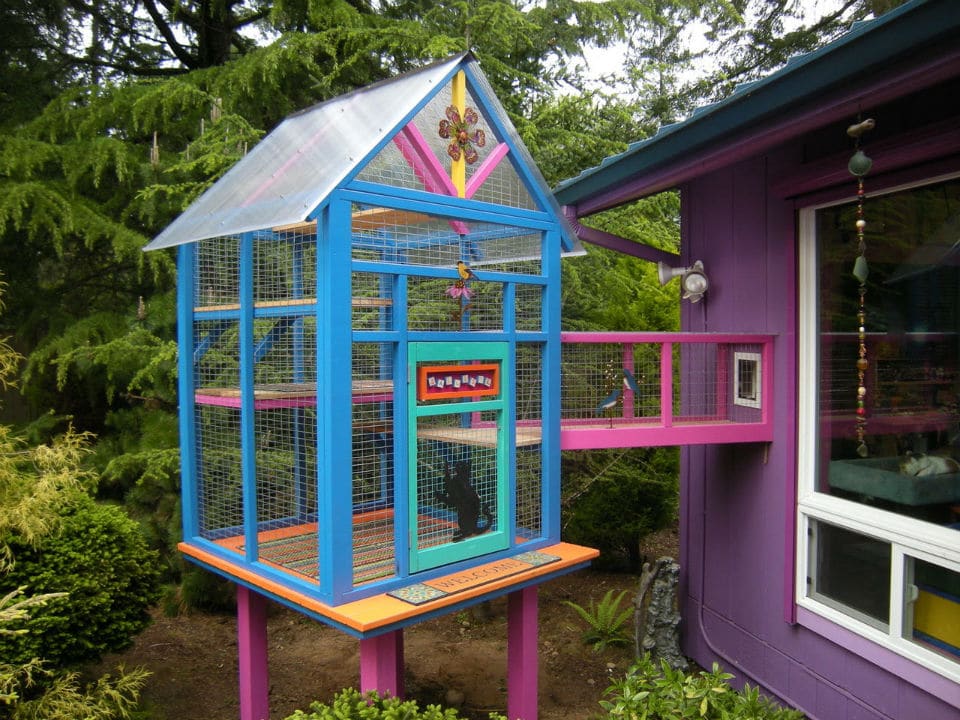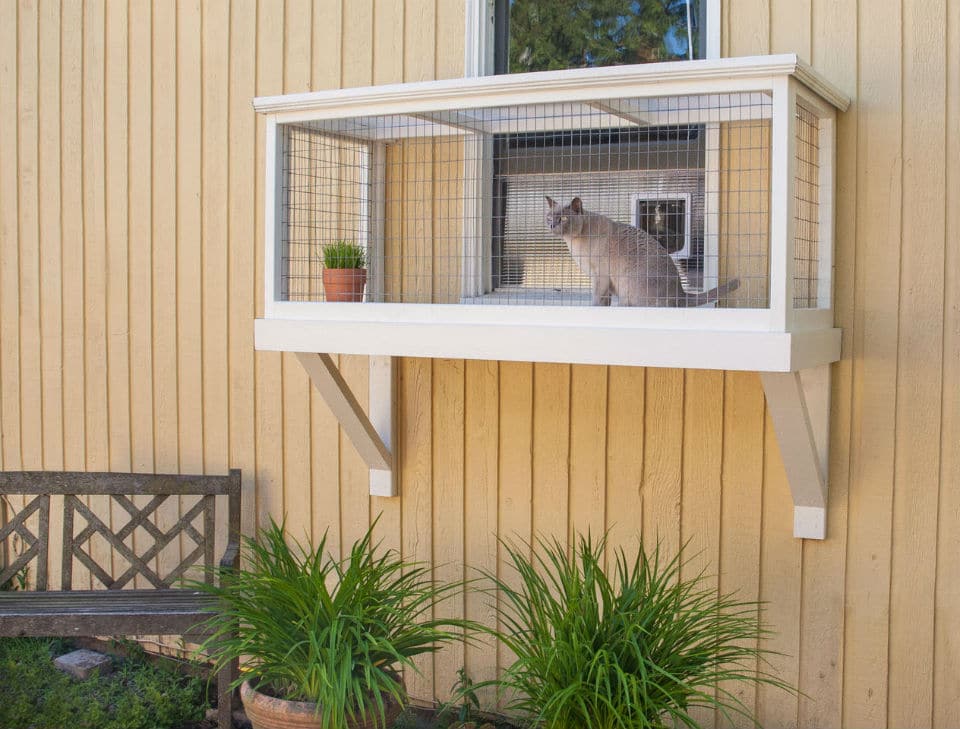If you’re a human, patios are a prime spot for outdoor recreation and relaxation. And if you’re a cat? There’s no better place than a catio. Curious about how to build a catio? Or what to consider when buying a pre-fab version? Read on—we have all the details.
Catios are a win for everyone: pet parents who want to give their cats plenty of time outdoors, cats who get to explore safely, and wildlife who stay safe from other cats.
But what, exactly, is a catio? What makes them a good choice for cats? And, if you do decide to add one to your home, should you attempt to build it yourself—or should you bring in the professionals?
Let’s dig in and find out!
How to Build a Catio: What Is a Catio?

Catio Spaces
So, first things first—what exactly is a catio?
Cynthia Chomos, designer and founder of Catio Spaces in Seattle, explains: “A catio is an outdoor cat enclosure or cat patio that’s designed to keep cats safe, healthy, and happy outdoors.”
Some are free-standing units, but most are attached to the cat’s home via a cat door and catwalk.
Typically, the catio is made of wood framing (such as solid, weather-resistant cedar) and sturdy wire. Choosing the right materials—and, in particular, the right kind of wire—is an important factor in deciding how to build a catio.
“Using galvanised welded wire or wire mesh will allow it to be an escape-free space,” says Chomos. “I don’t recommend chicken wire or plastic netting or anything like that…It’s important to have at least 14 to 16-gauge wire to enclose the unit.” The wire needs to be firmly attached so that your cat can’t get out or get injured—and predators can’t get in.
There are two different types of catios you can build or buy—freestanding and attached. Attached enclosures are three-sided and connected to the side of the house or to an existing porch or balcony. With an attached enclosure, your cat can come and go freely from a window or cat door into the outdoor enclosure.
Freestanding cat houses are usually set away from the house, on a patio or on the grass. That means you’ll have to carry (or lead-walk) your cat to the enclosure when you want to give them time outside.
How to Build a Catio: What Size?

Catio Spaces
There’s no one-size-fits-all solution. Catios can be as simple as a window box with just enough room for your cat to lounge or a more elaborate space with tunnels and plenty of places to perch.
“When it comes to size, it’s just a matter of how much space there is,” Chomos says. “You want the catio to complement the home and garden.”
If you’re limited on space, that’s OK! It’s more important to build a catio up than it is to build out.
“Cats love vertical space, so their enclosure doesn’t need to be huge,” Chomos points out. “A 3x6x8 foot [1x2x2.5 metre] catio would give plenty of vertical movement.”
If you have something more elaborate in mind for your kitty, there are plenty of large-scale options out there—especially for cat owners with multiple felines. If you have space, the sky’s the limit on building your catio design. Chomos recently designed a cat complex that includes more than 150 feet of elevated catwalks and tunnels! If you’re thinking about how to build a catio, her website has some elaborate designs that will definitely inspire you to go big.
How to Build a Catio: Why?

Catio Spaces
An investment in building a catio, large or small, has benefits for you and your cat:
- More outside time. Cats love the outdoors, and a catio gives an indoor cat an opportunity to expend energy.
- Safety for your cat. A catio gives your cat the opportunity to enjoy the outdoors without the risks—cars, predators, poisonous plants—that go along with roaming freely outside.
- Safety for your cat’s prey. Having an enclosed space not only keeps your cat safe, but also keeps birds (and other small wildlife) safe from your cat.
- Freedom to come and go. If your cat unit is attached to your home, your cat gets to decide where it goes, and when.
How to Build a Catio: DIY, Buy, or Hire a Contractor?
If you are an experienced DIY type, you’ll enjoy designing and building a catio. Chomos even offers an online guide to materials and planning and sells DIY catio plans. Check those out even if you are going to hire a professional to build you a custom catio.
Here are a few factors to consider in how you want to build your catio:
- Skill level. If you have some experience with carpentry, a DIY plan or kit is a great fit. But if you don’t exactly know your way around a toolbox, you might want to consider bringing in a professional.
- Cost. DIY plans are affordable but you’ll have to budget money for materials and time for construction. Hiring a professional can cost thousands of pounds, but it’s also the most convenient and time-efficient option. Before you decide, make sure to consider the full cost of building your catio and/or buying the unit (including time, labour, energy, and materials).
- Deadline. If you want and/or need your outdoor cat space completed by a specific date or season, that’s definitely something you want to consider before deciding to buy, build, or hire. Professionals may book out far in advance and DIY projects tend to take longer than you anticipate—so if you’re working on a tight deadline, a pre-assembled kit might be your best option.
- Regulations. Your city, development, homeowners’ association, or landlord may have some rules about catios. Be sure to check first before you buy materials or hire a contractor—there may be some guidelines for how to build a catio.
If you don’t have the time or skill to build a catio yourself, or the budget to hire a contractor, there are plenty of ready-made catios available to buy.



